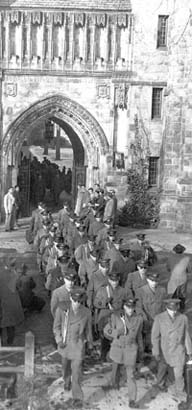A Record of Honor
Yale undergraduates and alumni have a record of service to their country that originated with the founding of the Republic and continues to this day. Captain Nathan Hale of the Class of 1773 was captured by the British and executed in September of 1776. He died, by the most famous account, with the words: “I only regret that I have but one life to lose for my country.” This first great military hero of the American Revolution is honored with a landmark statue on the Old Campus.
continues to this day. Captain Nathan Hale of the Class of 1773 was captured by the British and executed in September of 1776. He died, by the most famous account, with the words: “I only regret that I have but one life to lose for my country.” This first great military hero of the American Revolution is honored with a landmark statue on the Old Campus.
Since Hale’s day, Yale College men – and, since 1969, women- have continued to make their mark upon the nation, many through military service. Large numbers of them began their service through ROTC and other programs while studying at Yale. Prior to the United States’ entry into World War I, a group of Yale students were themselves instrumental in founding what would eventually develop into today’s Naval Air Reserve. One of them, David Ingalls, ’20, went on to become the first air ace in naval aviation history and is now remembered at Yale as the namesake of the Ingalls Rink, home of Yale’s hockey teams. Another member of that group, Robert Lovett, ’18, served in later years as Secretary of Defense; in his honor, Yale created a major endowed, senior faculty chair, the Robert A. Lovett Professorship of Military and Naval History, in the Department of History.
Time and again when called upon by their country, Yale graduates have served in the armed forces in disproportionately large numbers, when compared to the alumni and student bodies of other universities. Many have held leadership positions at the highest ranks, and some have used their military experience to benefit society in other ways, holding important posts in business, government, and education.
Others have given their lives in pursuing their duty. Yale honors them in perpetuity with the inscription of their names, classes, and records of service in the rotunda of Woolsey Hall, the University’s largest auditorium, and with the World War I Memorial in the Hewitt Quadrangle.